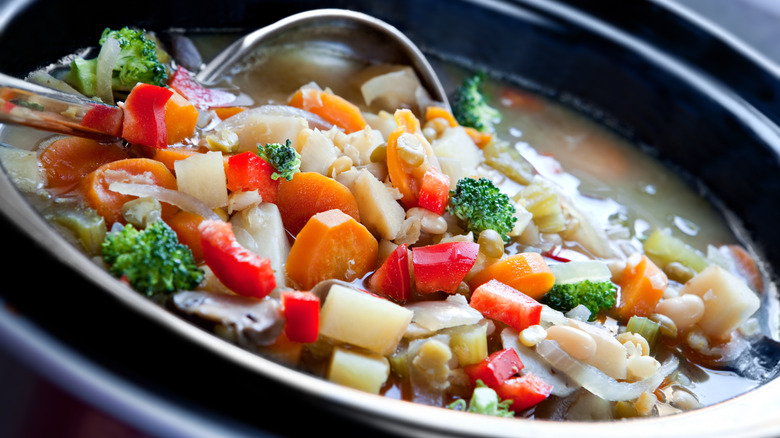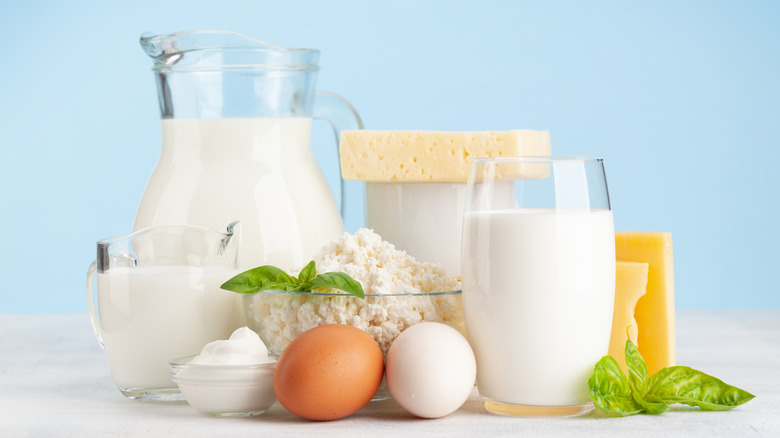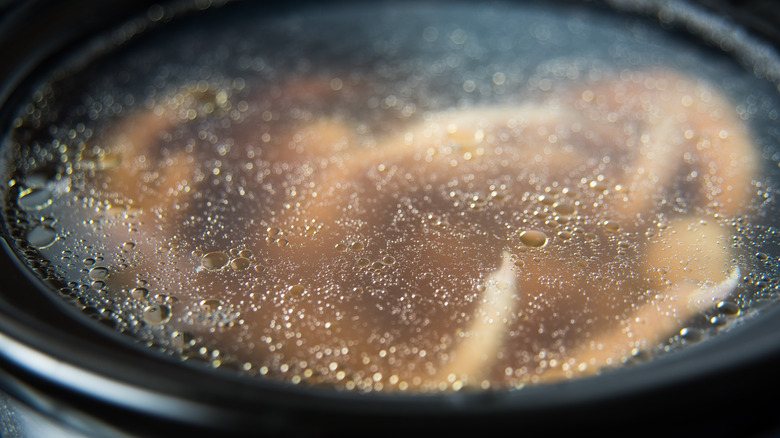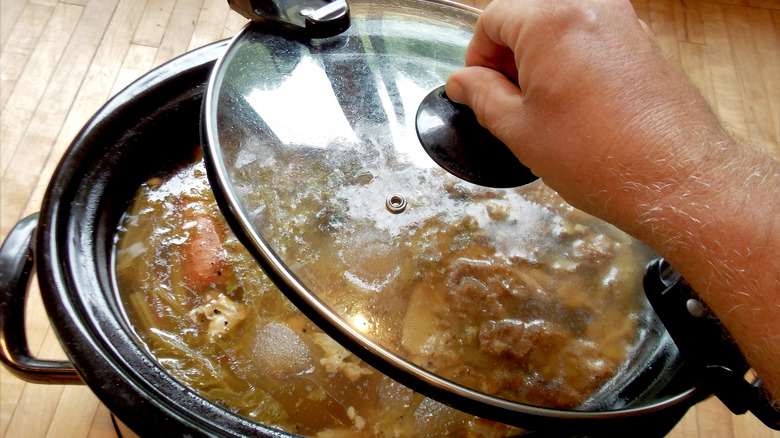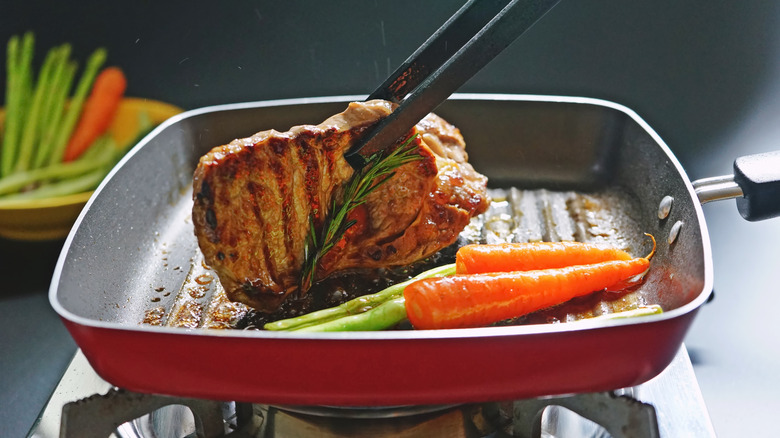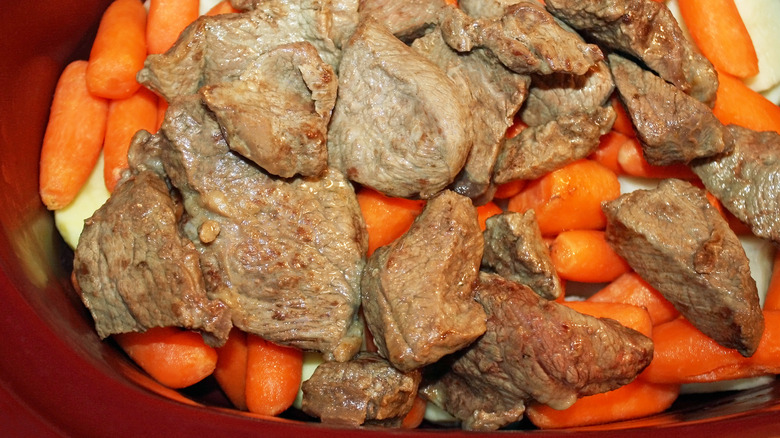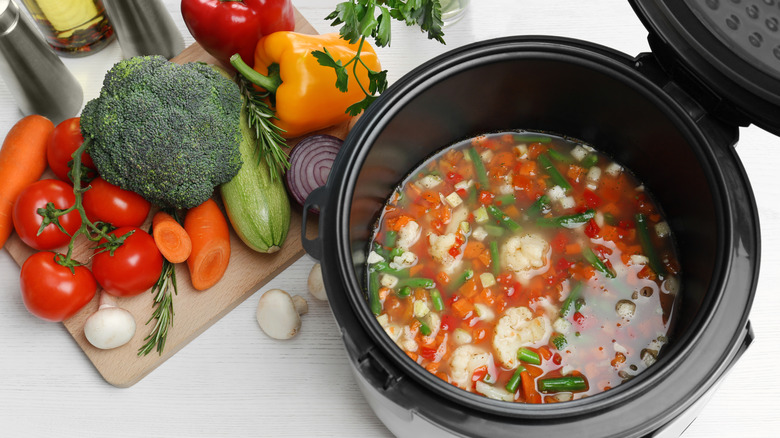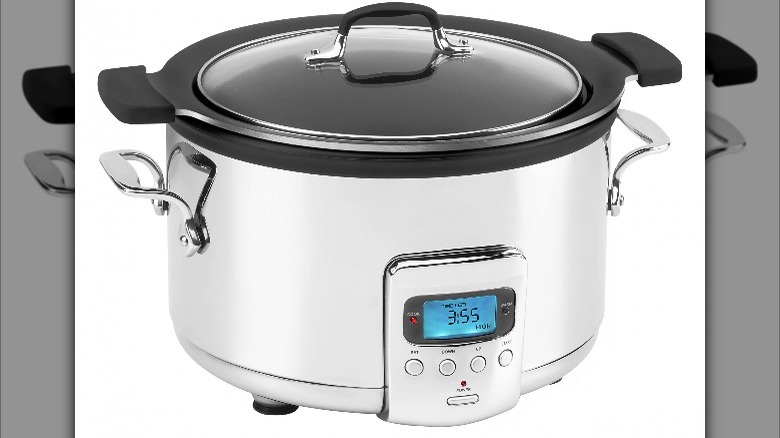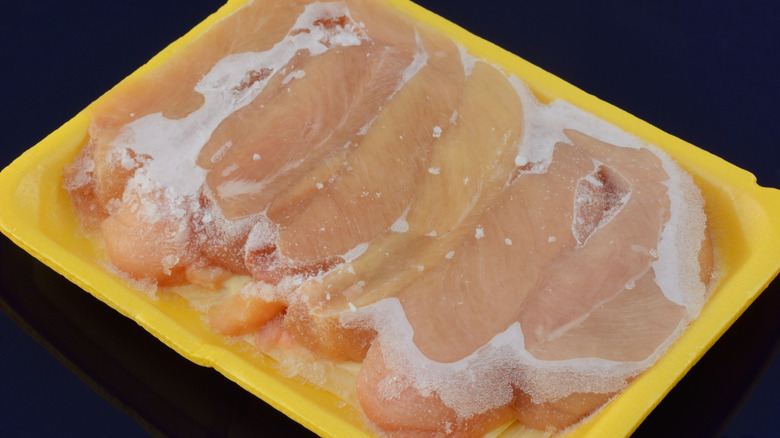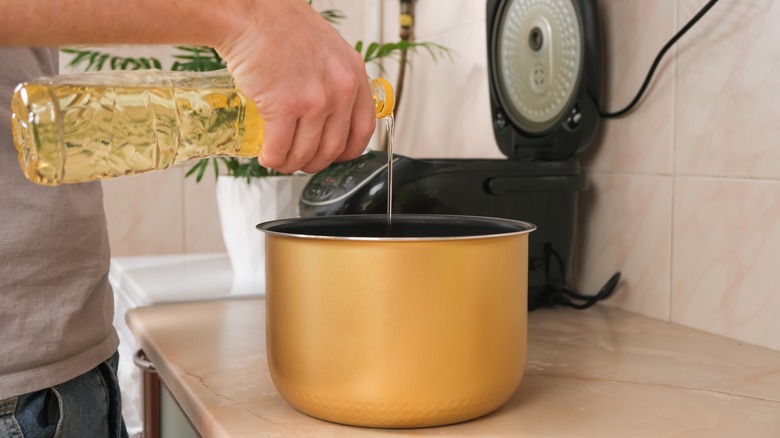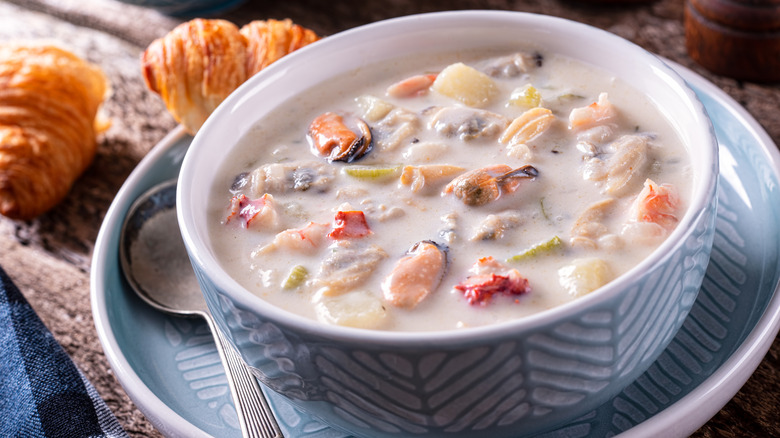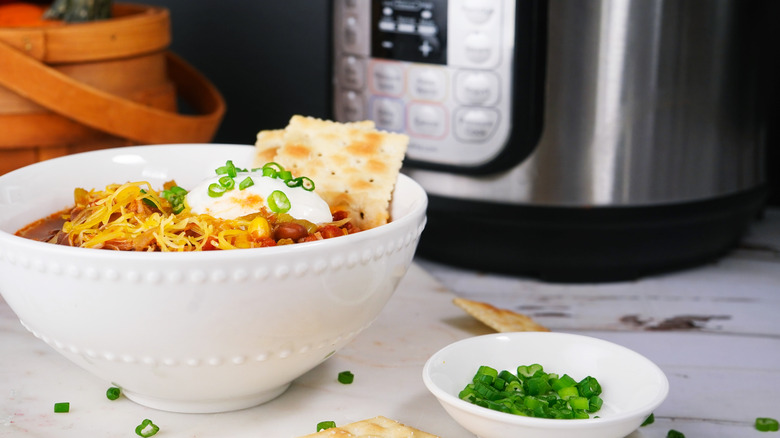11 Slow Cooker Mistakes To Avoid When Making Meals
Slow cookers are undoubtedly a timesaver for busy people. You can make soup, meat, and even desserts in the same vessel. As The Smithsonian Magazine recounts, the trusty appliance was invented by Irving Nachumsohn, who is also responsible for creating lava lamps and electric frying pans. Back then and at present, slow cookers are the perfect way to make dinner in the summer months without ever having to turn on the oven. Fast-forward more than 80 years and they are still a significant part of American cooking. In 2019, over 11 million slow cookers were sold in the U.S., per Statista.
But using a slow cooker isn't as easy as just throwing ingredients into the pot, closing the lid, and turning it to high. In fact, there's quite a bit of thought and prep that should go into making a meal in a slow cooker. Without these important steps, you might end up with food that is flavorless, mushy, and in some cases, unsafe to eat. Read on for the top tips on how to avoid making mistakes using your slow cooker.
1. Putting dairy in at the wrong time
Many amazing slow cooker dishes feature dairy, including soups and chicken entrees. However, you can't add these ingredients as soon as you start cooking. Instead, it's important to incorporate dairy, including milk, cheese, sour cream, and yogurt, later in the cooking process.
Dairy products will quickly curdle if they cook at hot temperatures. Ideally, you should add them within the last 15 minutes of slow cooking, or right before the food is plated. For example, simply add milk or Greek yogurt for creaminess at the end of the cooking process, or top off your meal with a dollop of sour cream or a sprinkling of shredded cheese.
If you're not sure about the specifics of making a slow cooker recipe with dairy, you can always choose dishes that are dairy-free. Alternatively, be sure to follow the timing recommended in the recipe to avoid accidentally curdling your meal.
2. Not using enough liquid
The premise of the slow cooker meal seems simple enough — add the ingredients, close the lid, and choose a cooking time. But one of the big rules of using a slow cooker is making sure the meat, vegetables, and other ingredients are properly covered in liquid. You can overdo it though, and The University of Minnesota Extension advises reading your slow cooker manual to make sure you're not overfilling it. The outlet notes that depending on the manufacturer, the crock should be filled half to three-quarters full.
TD Kitchen recommends adding about two cups of water for standard recipes. Meanwhile, if you're making soup, add three to four cups of water. As the liquid heats up, the steam will help cook the food. You should still be careful not to add too much liquid, as it could boil over or cause the food to become mushy. While each recipe will tell you what liquid and how much of it to include, instead of water you could substitute chicken, vegetable, or beef broth for added flavor.
3. Opening the lid during cooking
It can be very tempting to open your slow cooker's lid during the cooking process to stir, taste, or just see how it's coming along. But don't do it. Peek through the glass lid if you must, but don't lift it. Since food in a slow cooker cooks from the steam generated within, when you open the lid a lot of that steam and thermal energy is released.
The University of Minnesota Extension warns that steam release from an open lid slows down the cooking process and reduces the food temperature by 10 to 15 degrees, which means you'll need to cook your dish for an additional 30 minutes. That's a lot of time added to the clock for a glimpse at what's cooking, right? Patience is definitely necessary when cooking with a slow cooker. You simply have to trust the process, or you risk adding more cooking time.
4. Not browning the meat before slow cooking
There's some debate about whether you need to brown meat before cooking it in a slow cooker. As Boss the Kitchen explains, it's not a requirement but doing so can help your dish taste more flavorful and have a better texture. Provided the meat is not frozen, a slow cooker can cook meat and other ingredients fully without prior cooking.
Still, searing beef, chicken, or other meats can help boost your food's flavor profile, which is one of the major reasons to use a slow cooker. Searing the meat also gives it a caramelized look and taste. Plus, it can help cook off some excess fat which is especially important since your slow cooker can't accomplish that. Browning the meat might help speed up the cooking process for some recipes, but not all of them.
Understandably, pre-cooking meat is an extra step that not everyone wants to do. It takes more time and it requires more cleanup. But experimenting with recipes and techniques are some of the joys of a slow cooker, so it might be worth it to try the same dish twice — once searing the meat before cooking it in the slow cooker and the other time simply popping it into the pot.
5. Not layering ingredients the right way
For best results with a slow cooker, it's smart to properly layer your ingredients in the pot. Start by placing meat and hearty vegetables like potatoes and turnips in the bottom of the ceramic crock where they will be closest to the heat source. These ingredients typically need a longer time to cook, compared to more delicate ingredients like leafy greens, which should be placed closer to the top of the crock and added near the end of the cooking time.
Start with a fattier cut of meat, which retains moisture and produces tender meat. For example, sear a chuck roast and then place it in the slow cooker, followed by onions, garlic, and a mixture of beef broth with all the browned bits from searing. Next, layer in vegetables like carrots and potatoes and cook the meal on a low setting for eight to nine hours.
6. Not properly cooking vegetables
You'll want to take special care when adding vegetables to a slow cooker meal. It's best to cook hearty vegetables, like potatoes, beets, and carrots on the bottom and/or sides of the crock since these ingredients are the slowest to cook and need direct heat generated from the bottom of the device.
You can cook some veggies at the end by turning the slow cooker to a high setting for the last hour. Make sure the vegetables are covered in plenty of liquid, such as chicken or beef broth, and they'll be perfectly tender. Smart Slow Cooker recommends adding tomatoes, peas, and leafy greens like spinach, kale, or chard to the slow cooker within the last five to 10 minutes of cooking. Veggies including zucchini, asparagus, and okra need a little more time to cook, so plan to add them to the slow cooker within 15 minutes to a half hour before dinner.
As for adding fresh herbs, Crock Pot Canada recommends adding them to the plated dish, not during cooking. That's because fresh herbs will lose their flavor during the long and slow cooking process. However, some herbs like rosemary are hearty enough to withstand slow cooking.
7. Not understanding heat settings
It's important to pay careful attention to your slow cooker settings. A good place to start is by reading the manual to understand its various settings. Most slow cookers have a high, low, and warm setting. The range of temperatures tends to start around 170 F and goes up to 280 F or so. Warming temperatures are slightly lower — hot enough to keep food from getting cold, but not hot enough to keep cooking them.
Pre-heating your slow cooker is another essential step that people often skip. It might seem fine to toss your ingredients into the vessel and turn it on, but consider it similar to an oven. Getting it to temperature before adding the food will help everything cook evenly.
Although slow cookers are meant to save time and allow you to prep the components in advance, it's important to store pre-chopped veggies, sauces, or meat in a separate container. If you refrigerate them in the actual crock insert, the ceramic can easily crack once you place it back in the slow cooker due to the extreme temperature change.
8. Not thawing frozen items first
According to the U.S. Department of Agriculture (USDA), it's important to thaw meat and chicken before adding it to your slow cooker. Be sure to do so in the refrigerator to avoid potential health risks. Once it's thawed and ready to cook, you can place it in the crock and continue with your recipe.
Even though the cooker is heating up, it can take a few hours for the appliance to reach a temperature that will kill bacteria. To reduce risks, cook your food on high for the first hour to ensure meats and poultry reach 140 F. This temperature lies just outside the so-called danger zone where bacteria can proliferate, according to The University of Minnesota Extension. Aim for an internal temperature of a minimum of 165 F before removing the food to eat.
If your ingredients are frozen when they go into the slow cooker, you and anyone who eats the food could risk getting sick. Even if no one gets sick, the food won't be at its best because the cooking process will be uneven due to the temperature differences in ingredients.
9. Forgetting to grease the slow cooker
You grease the pan when baking brownies, preparing chicken, and making many other dishes, so why should your slow cooker be any different? The goal is to prevent food from sticking to the bottom and sides of the ceramic pot. Greasing your slow cooker will protect the appliance for long-term use and best of all, it'll make cleaning up a lot easier in the short term.
Lightly spray a nonstick cooking spray inside the crock to grease it. Another option is to invest in slow cooker liner bags, which are durable enough to withstand the heat from cooking and provide you with a fuss-free cleanup. It's worth noting that you can't use just any bag you have around the house or it might burn. Liner bags specifically made for slow cookers are designed with materials that can tolerate very high temperatures, while a bag that's not made for the appliance will likely burn, ruin your dinner, and could damage your slow cooker.
10. Cooking certain ingredients too long
Some ingredients don't fare well if you put them in the slow cooker for a long time. For example, seafood, rice, and pasta have shorter cook times and can't withstand the lengthy process. Rice is a challenging ingredient because it can easily get mushy. Your best bet is to add it to the slow cooker when you have two hours left of cooking and the appliance is set on high. Pasta is another tough ingredient that gets soggy fast if prepared wrong. Add it with one cup of hot water when there are 30 minutes of cook time left.
When it comes to cooking fish, City Fish Market recommends cooking fish fillets in a crockpot on high for two hours. Meanwhile, if you're making a seafood chowder or stew then start by cooking the vegetables and liquids for two to three hours on high. Only add the seafood about 30 minutes to an hour before the end of the cooking time to keep the texture pleasant.
11. Using your slow cooker to reheat leftovers
Cooking with a slow cooker can yield a high volume of food, but you shouldn't leave leftovers in the crock for a long time. It's important to refrigerate any remaining food as soon as possible. Leftovers stored in your fridge should be safe to eat for three to four days. After that, you'll likely have to throw them out or you could risk getting sick from bacteria that grows on old food (via Mayo Clinic).
For food safety, you definitely don't want to leave the food in the slow cooker for more than two hours, and nor should you use the appliance to reheat any leftovers (via University of Minnesota Extension). Instead, heat leftovers in the microwave, in the oven, or on the stove. Use a food thermometer to check the food's internal temperature, making sure it reaches at least 165 F before you eat it.
